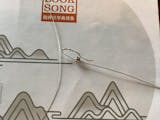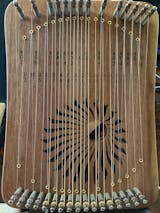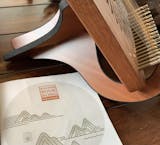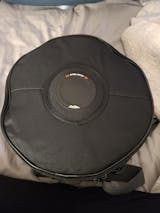How to Approach Handpan Scales
A typical handpan has 8, 9, 10 or 12 notes. If that sounds limiting... remember that each handpan note holds at least 3 frequencies (the fundamental note, the octave and the compound fifth on a 1:2:3 ratio). That rich layered sound is what makes handpans so satisfying. Besides, the concept of handpans works precisely because of its limited number of notes, not in spite of it. As a result, the handpan is primarily intuitive (not intellectual) which means you get to create music freely without worrying too much about music theory.
But since the handpan is limited to one scale... picking the right scale is still important! But how do you pick a handpan? Look, I don't you know about you... but I'm not classically trained. I never studied music but I did train my ears to recognize the 'sound flavor' in each handpan scale. And I think you can do it too.
All handpan scales pretty much fall into one of two categories:
-
MAJOR: Does it sound happy, joyful or peaceful?
-
MINOR: Does it sound sad, melancholic or tragic?
As you listen to handpan videos, ask yourself if the instrument sounds "major" or "minor" or "flavorful". That simple exercice will put you one step closer to knowing which handpan scale is the right one for you.
1) Major: Handpans with Happy Scales
Why wouldn't you want a major handpan scale? While handpans with major scales can instantly bring you feelings of joy, they may lack the tension or the emotion that comes with minor scales.
2) Minor: Handpans with Sad Scales
Minor-sounding scales are much more than just sad... They're complex, classical, sometimes dark and overall more emotional. Having a handpan in a minor scale will allow you to express powerful feelings through your music, to create tension, suspense and a sense of mystery...
Why wouldn't you want a minor scale? Being locked into a minor scale has its down sides too. It can feel emotionally heavy to play your handpan at times when all you really want is a simple moment of joy.
HLURU Handpan Drum
------------------------------------------------------------------------------------------------------
Choosing a Scale
Choosing a scale is all down to personal preference. Listen to lots of different handpans / pantam online and note what you like. But remember: you may like the style of a particular handpan musician as much as the handpan itself, and there’s nothing wrong with that but just bear it in mind as it will influence your preferences.
Scale names are confusing – Hijaz? Kurd? What does this mean?
Try not to worry about this too much for now. Remember to write down the actual notes of the scales that you like. Every handpan scale can come in a range of keys depending on your choice for your ding and can have a different name depending on the maker. Don’t be confused by this; help yourself by writing down the actual notes of the scales that you like.
Make sure to use headphones
Otherwise you will miss out on the delicious bassy tones, especially in the lower pitched handpans!
Lower ding VS Higher ding
How frequently will you use your ding? Will you play more percussively or compose melodies? You may or may not know the answer to this yet. Something you might wish to note for all handpans is that the lower the pitch of your ding, the bassier and more satisfying the sound is to strike it.
For me, I don’t get the same satisfaction from a ding above an Eb anymore but as a beginner 10 years ago I really couldn’t tell the difference.
Popular scales
The majority of handpan scales are a variation on either a major, minor or harmonic minor key.
The major scales are happy and uplifting and popular with beginners, minor keys are moodier and harmonic minor have a more middle eastern flavour full of suspense. Beginners often tend to feel less comfortable with Harmonic Minor / Hijaz scales. My recommendation would be for a beginner to choose a major or minor handpan.
Most scales in music have 7 notes. E.g. C major C D E F G A B or D minor D E F G A Bb C. Handpan scales often omit one or two notes in a scale and this leads to such a wide variety of instruments.
For your ease of comparison I have written out in the scale of D the notes of each of a selection of popular scales, though you will find the scales in reality may have a different central note e.g. La Sirena common in E.
Kurd / Annaziska (MINOR):
- Kurd
- All the notes and chords from the minor scale.
- Many harmonic possibilities with intuitive natural chord progression.
- Popular scale
- Easy to play with other handpan
- Good to play with other instruments.
- Styles : From dreamy to mystical to happy and hopeful
- Mysterious and meditative, the Kurd scale is among the most popular Hand Pan Scales ever made as it is basically a full minor scale.
- The Kurd scale is a full natural minor handpan scale, which means it has all the notes in the key of D minor. It is also sometimes referred to as Aeolian mode in western music theory. This mysterious and meditative scale is among the most popular handpan scales ever made.
- The Kurd scale can be played on a handpan by following the notes in the key of D minor (D, A, Bb, C, E, F, G, A). The layout of the notes on the drum can impact how you play them, so it's essential to familiarize yourself with the handpan's note placement.
- The Kurd scale is known for its mysterious and meditative sound. It offers a peaceful and insistent scale that can evoke a wide range of emotions, from tension and darkness to brightness and joy. This versatility makes it a popular choice for handpan players of all skill levels.
- The Kurd scale has gained popularity in part due to early viral videos by Hang Massive, Daniel Waples, and David Swarup, which showcased the captivating sound of D minor handpans. Additionally, Sam Maher's viral video of a C# Kurd, also referred to as "Annaziska," has further popularized the scale.
- C# ANNAZISKA
- The C# Annaziska scale is another very popular handpan for beginners. Exactly like the D Kurd/Aeolian in layout, but half a step lower, making it a deeper sounding handpan. This handpan is constructed to be resonant and playable with a light touch.
Celtic / Amara (MINOR):
- The Celtic Minor or Amara is based on the scale that is common in traditional Celtic music. The absence of the sixth makes this scale even more intuitive and harmonious. Suitable for every beginner. Version of the typical Irish or Scottish hexatonic Dorian/minor scale.
- Creates a suspended mood, oriented towards minor 7th chords and sounds, avoids the tension created by diminished chords.
- Styles : intuitive, easy to connect with emotionally, beautiful, touching and inspiring. Great for meditation.
Hijaz (MINOR):
- Version of an harmonic minor scale.
- Typical oriental sound.
- Suitable for percussive playing and oriental or spanish sounding melodies.
- Styles :Arabic melodies and atmospheres.
- The Hijaz scale is very common in Middle Eastern, Arabic, Flamenco and classical music. It is also quite common in many movie scores. It has often referred to this variety of scales admiringly as “Spicy”.
- These variations can be very suspenseful but also compelling, mysterious, exotic, and even quite sensual like a romantic breeze from the desert sands of timelessness. 😉
- The Hijaz scale is a Harmonic Minor. The only difference from the minor scale is a sharpened 7th note of the scale, which provides a compelling and triumphant major chord to dance around when playing progressions. Depending on which note is the foundation of a melody, it can also be considered a Phrygian Dominant scale.
- The phrygian mode is based upon the third degree of the major scale; as such, it is a minor scale. Its predominant characteristic is a flatted second degree, which gives it a “middle east” or “exotic” sound. Otherwise, it's the same as a natural minor.
- The Phrygian mode is a mode that’s in many ways similar to minor, but features a flattened second (♭ˆ2) as its distinguishing feature. If we started on E, then its ascending scale would consist of E, F, G, A, B, C, D, and E.
- Hexatonic version of a Dorian scale.
- Minor scale with a major sixth, giving it a slighter major character
- It presents a minor 3rd and a minor 7th.
- The root note is the Ding, followed by the sequence to build the root minor chord. It is a very versatile scale, as the sequence of notes can highlight a natural minor scale starting from the 5th degree of the scale or a major scale starting from the 3rd degree. The absence of the subdominant note makes this version suitable to play over several major and relative minor scales.
- Styles : mysterious, romantic, a dreamy atmosphere, smooth jazz, joyfulness.
Sabye (MAJOR):
- Diatonic version of a Lydian modal scale.
- The root note is the second lower note of the scale, while the ding is its perfect fifth, a note that finds its melodic resolution on the root of the scale.
- The Lydian mode is very similar to the major scale mode: the only difference is the augmented fourth interval, which gives it its heavenly and uplifting character.
- The peculiarity of the Sabye scale is also its last note, which is deliberately different from the root note of the Lydian scale
- Styles : intriguing suspended atmosphere.
Equinox (MINOR):
- Hexatonic minor scale.
- The root note on the Ding, followed by the minor 3rd and perfect 5th on the lower register emphasize the minor mode of this scale.
- Nice balance between major and minor moods.
- Styles : harmony, calmness and equlilibrium.
Aegean:
- The Aegean tuning is a divine scale that is said to usher in showers of rain when chanted. The associated moods are grandeur, attraction, lightness and passionate joy. According to spiritual belief, the tone combinations in this scale are said to evoke inner vision.
Mystic:
- Hexatonic natural minor scale.
- The missing tone is again the perfect fourth, the same situation of the Integral scale.
- Has the minor seventh as the last and highest sounding note of the scale, dividing the register of the handpan in two sections, a lower one with the presence of the perfect fifth and minor sixth, and a higher one where the other notes of the scale contribute to underline a melody built over the persistent sound of the root note.
- Styles : this tuning captures the magic and mystery of Arabian nights, creating soundscapes as mesmerizing as belly dancing under the stars.
- In music, the mystic chord or Prometheus chord is a six-note synthetic chord and its associated scale, or pitch collection; which loosely serves as the harmonic and melodic basis for some of the later pieces by Russian composer Alexander Scriabin. Scriabin, however, did not use the chord directly but rather derived material from its transpositions.
- When rooted in C, the mystic chord consists of the pitch classes: C, F♯, B♭, E, A, D.
- This is often interpreted as a quartal hexachord consisting of an augmented fourth, diminished fourth, augmented fourth, and two perfect fourths. The chord is related to other pitch collections, such as being a hexatonic subset of the overtone scale, also known in jazz circles as the Lydian dominant scale, lacking the perfect fifth.
- The ''Mystic'' scale is a fascinating blend of Middle Eastern melodies and mystical charm. Inspired by the traditional Hijaz scale, this tuning captures the magic and mystery of Arabian nights, creating soundscapes as mesmerizing as belly dancing under the stars.
- Mysterious Harmony of the East The sounds of this scale are like tales from a thousand and one nights, each note telling its own story, full of mystery and mystical allure. It’s a musical journey that transports the listener to a world filled with magic and unspoken depth.
Pygmy:
- Incorporating the Pygmy Scale in Handpan Music.
- The Pygmy scale is another fascinating handpan scale, characterized by its minor key and intriguing suspended atmosphere. This scale is often associated with joyfulness and shares a common root note in the Dorian scale, making it an interesting choice for those who enjoy the mystical sound of both scales.
Low Pygmy (MINOR):
- Pentatonic version of a minor scale.
- It has its root note on the Ding, and then a major 2nd, its minor 3rd, perfect 5th and minor 7th.
- A deeper variation of the "Pygmy", starting at the second in the ring around the Ding. This requires a different way of playing, which in our eyes is especially suitable for melodic playing. We recommend it to advanced players.
Asha / Ashakiran:
- "Asha" is literally translated as "hope", and "Ashakiran" as "ray of hope". She animates to cheerful, light, melancholic, hopeful melodies. While the Asha classical has only 8 tones on the upper shell, the Ashakiran is extended by a ninth tone on that one and receives at least three tones on the lower shell. Especially the second and third in the lower range and the fourth in the upper, complete the already rich Asha to a Handpan that leaves nothing to be desired.
Myxolidian (MAJOR)
- Hexatonic version of the fifth mode of the major scale.
- The root note is on the Ding, moving on towards the perfect fifth and major sixth, but omitting the minor seventh to underline the role of the root note.
- In this case, it can also be considered as a major scale without its seventh, serving the purpose of the two main major modal scales.
- Styles : happy, peacefu, perfect for music therapy.
- The YshaSavita scale is a form of hexatonic major scale without its sixth grade. It sounds as a happy and refreshing major progression, filling the player and the listeners with energy and positive vibrations. It's low center note, is expressive and mood-lifting, great for relaxing or meditation.
- The majority of the intervals are oriented towards major progressions and sounds, avoiding stable minor structures. Along with other minor scales handpans, it can be the perfect complement for advanced players who wish to complete their favorite setting only adding one other instrument.
Aeolian (MINOR)
- Complete natural minor scale.
- The presence of the low fifth on the ding along with the complete sequence of the aeolian/minor scale note is the perfect display to build all scale chords and melodic sequences.
- Full diatonic scale, with the advantage of having no other notes repeated aside from the central ding.
- Characterised by its distinctive intervals and haunting melodic contours, the Byzantine scale stands apart from traditional Western scales.
- The Byzantine Scale, also known as the Double Harmonic Scale, has a configuration that produces an exotic sound. The Byzantine scale can be thought of as a Phyrgian scale with a raised third and a raised 7th. What characterizes this scale are the whole and a half semi-step intervals between the second and third and the sixth and seventh notes.
- A scale invented by Matthieu of Shellopan, one can play Akebono, Pygmy and Equinox on this scale and hence, this scale has great potential for creating compositions and would require rigor and practice in order to master the different scales, and not be tempted to attempt to play all 3 scales at once.
Blues (MINOR)
- Experimental, yet effective handpan version of the world blues scale.
- Minor pentatonic with the addition of a chromatic note between the fourth and fifth degree, the famous blue note.
Akebono
- Pentatonic scale obtained from the traditional Japanese diatonic scale In.
- characterized by minor-second intervals between the first and the second note of the group, and a perfect fourth between the first and the last note in the group.
- In this handpan version, the ding is the root of the scale, followed by the fourth and the fifth, defining the limits of the two three-note groups and introducing its mood.
- Styles : The result is a deep and hypnotic scale, an introspective immersion in the oriental sound of this music scale.
Harmonic (MINOR):
- This scale is also a bit "spicy". The tone structure is similar to that of the "Kurd" or "Annaziska", except that here the seventh is increased and thus gives the oriental flavor. On this scale you can play wonderfully melodic as well as percussive.
MAGIC VOYAGE (MINOR)
- Pentatonic version of a minor scale.
- Similar to the Low Pygmy scale.
- It has its root note on the Ding, the minor 3rd, perfect 5th and minor 7th, and then its major 2nd.
- Styles : dreamy, effective, beautiful, deep and sustained harmonics.
PIGMY (MINOR)
- Form of Dorian pentatonic scale.
- Intervals and repeated fifths deliver a deep and full scale with no Precise central tone but brilliant and resonant, making it useful in several major and minor progressions.
- Styles : gentle, sweet, inspires introspection and meditation. Indian flavor.
PENTATONIC (MAJOR)
- Major scale without the fourth and the seventh notes.
- In one of the most classical versions, it eliminates all the half tones intervals, creating a stable and strong major movement.
- By having five tones over eight or nine notes, the result is also the natural repetition of three notes over two octaves, creating full resonance and brilliance.
- Along with a stable and consonant progression, it can be played over minor and major scales alike, representing a good choice for beginner players who wish to focus on percussion.
Japanese mode
- A feature of traditional Japanese music which at taches importance to a fine and smooth change of - pitch intonation as a way of musical expression rather than quick and wide movement.
Chinese mode
- The modern Chinese national pentatonic modes theory based on the five tones of Gong, Shang, Jue, Zhi and Yu was created by Chinese musicians who combined music theories such as absolute pitch, twelve-tone equal temperament and major/minor modes used in western music with Chinese music theory after the early twentieth century.
Stainless Steel?
What material you would like your handpan to be made of is an important decision – seek further guidance from the maker. In general a handpan made from stainless steel has much greater sustain. This lends itself well to meditation and slow composition but not to fast playing.
440 Hz vs 432 Hz
If you want to be able to play with other musicians choose 440hz. If you are looking for an instrument to be played alone for sound therapy and meditation you might want to consider an instrument with A = 432hz as this frequency is believed to vibrate in tune with the earth and reduce anxiety.
Please refer to:
432 Hz vs 440 Hz (Differences, Tuning, Which Sounds Better?)






2 bình luận
Hi, I looking for to buy hand pan for long time now… Its not thing I need to have straight tomorrow but time running fast and I really want this instrument. I am completely new in this but I read your web carefully to understand differences. From what I read I assume am closer to minor hand pan with deeper “middle eastern like” music sound and probably 432 Hz cause I want it for relaxation. I do not think Major pans are for me assuming on the base of your descriptions and videos I sow. So most closer sound I prefer is following hand pan :
HLURU Kurd Scale/Celtic Scale in 432 Hz and 440 Hz D Minor 22 In 9 Notes Nitride Steel Handpan Drum
Please be so Kind and let me know what are the options you may offer in this range.
All I want at this stage is make clear what are models you may recommend me in this range.
I can buy pan in the summer when I will travel to the south so I can stop personally in your shop to make sure I will pick right model on first time.
Have great day
Lucky
Bonjour je ne connaissais pas cet instrument il y a seulement 6 mois. Je suis moi même musicien en piano et Saxo, cet instrument a beaucoup de possibilités, majeurs et mineurs, pas besoin d’être musicien pour se faire plaisir…..je vais écouter plusieurs de ces instruments “les handpans” et faire un choix.
Dans le bien être musicaleet autres, nous pouvons développer des sensations fortes….. merci pour ce partage.
cordialement Jp